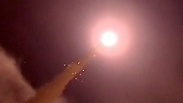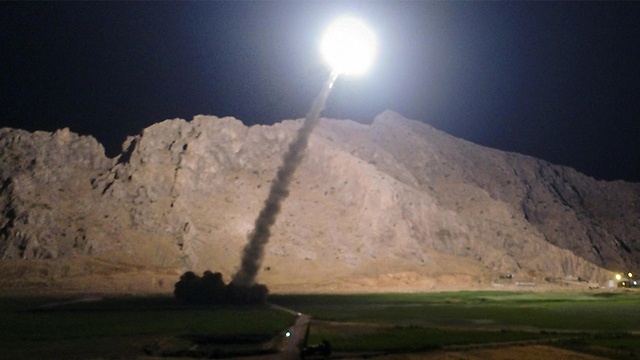
Only two of the six missiles fired by Iran reached their target
צילום: רויטרס
A miserable failure for Iran’s military industry
Analysis: If there is any military-political message in the Iranian missile strike on ISIS targets in Syria, it appears to be directed at the Gulf states and Saudi Arabia rather than at Israel. Satellite images, if verified, indicate that the first barrage in 30 years of Iranian ballistic missiles at targets outside Iran was an operational failure.
The first reports received by the American satellite system detected four Iranian missile hits in the Iraqi desert and four hits in the Deir ez-Zor area in Syria. If the satellite images are verified, they will indicate that the first barrage in 30 years of Iranian ballistic missiles fired at targets outside Iran was an operational failure. The Iranian military industry experienced a miserable failure.

Six missiles were fired, but only two of them reached their target. Furthermore, the accuracy of the hit and the extent of damage caused to the Islamic State facility remains unclear. The video presented by the Iranians shows only one explosion, which hit a building.
The Iranian strategic power is not a paper tiger, but it’s far from being the demonic threat portrayed by the heads of the IDF at the beginning of the decade in a bid to prevent the political echelon from attacking the Iranian nuclear abilities. The Iranian missile technology is inferior to the technology we are familiar with in developed countries, and it’s quite likely that the Iranian military industry is now looking into the nature of the failures to determine whether they were the result of a development problem or a production problem. All we are talking about is a new surface-to-surface missile which was first seen in an annual parade in Tehran in September 2016.

Iranian missile strike in Syria. Iran’s missile technology is inferior to the technology we are familiar with in developed countries (Photo: AP) (צילום: AP)
Warplane attacks have a major, accurate and more impressive effect, but the Iranians chose to use surface-to-surface missiles, as any attempt to bring planes into the Syrian airspace would have ended in their downing by the American coalition or by the Russians. This is where the Iranians exposed one of their weak spots: Their warplane fleet is outdated. Furthermore, it took them a long time to respond to the ISIS attack on the Iranian parliament in Tehran, likely due to their intelligence collection abilities and the Iranian leadership’s decision-making process.
Nevertheless, a barrage of six missiles demonstrates that the Iranian army has fire units as big as regiments which operate this model. The ISIS attack in Tehran gave the Iranians a reason to operationally test-fire this missile, for the first time, in real-time conditions—just like Syria serves as an experimental field for modern weapons for the Russians.
If there is any military-political signal in this missile fire, it appears to be directed at the Gulf states and Saudi Arabia rather than at Israel. The Zulfiqar missiles used by Iran cover these countries, and the Iranians are indicating that the barrier which has curbed the firing of missiles outside Iranian soil up until now has been broken. If the Gulf states and Saudi Arabia threaten the Iranian national interest—they will become a target.
The Zulfiqar missile belongs to a veteran family of missiles which has been around the region for many years now and includes the three Fateh-110 models with a range of about 350 kilometers, and the Fateh-313 with a range of 500 kilometers. According to foreign sources, these missiles may have also reached Lebanon over the years. The Zulfiqar missile will only put Israel at risk if it is stationed on Lebanese soil, but the Iranians have no reason to try to smuggle this kind of missiles into Lebanon at the risk of having them destroyed on the way, as there already are missiles in Lebanon with an effective range that covers most Israeli territory. Not to mention the fact that the accuracy of the Fateh missiles, as well as the long-range Zelzal-3 rockets in Lebanon, can be improved.
The other side of the story is the Wall Street Journal report that in the past three years Israel has been supplying rebels in the Syrian Golan Heights with limited military and financial aid. Just like the Iranians are making an effort to increase their influence in Syria and to position themselves against Israel not only in Lebanon but also in the Golan Heights, Israel is doing its utmost—both through diplomatic means and through military means—to thwart this trend.
We should not rule out the possibility that the alleged connection between Israel and the Golan residents who are rebelling against Assad is one of the measures aimed at making it difficult for the Iranians and Hezbollah to put down roots in the northern border. In the long run, Israel cannot rely on the rebels to stop the Iranian spillover into the Golan border, which is why the aid it is providing—apart from humanitarian aid—is limited.
The experience gained by Israel in southern Lebanon with the South Lebanon Army serves as a reminder to our defense ministers that we should be careful when we embrace and rely on our new allies, as these love affairs usually end in disappointment.










